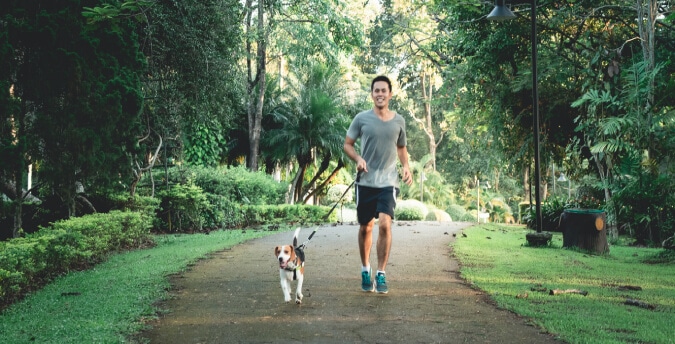Can I Take My Dog Running With Me?

Running is a great exercise for us and we all know that it can help humans get in shape and start becoming healthy. However, did you know that running can also be good for your dog? Do you want to take your dog running with you? It is important to know that not all dogs are built for running, but it can usually be handled by most. Nonetheless, there are still some things to consider if you are planning to take your dog running with you.
Check Your Dog’s Health
Before finally deciding to start running with your pet, it is vital to consult with your veterinarian first. Running can cause certain impacts and may even lead to injuries for your dog if it isn’t done properly. If your dog has certain conditions like hip dysplasia or arthritis, it can be painful for your pet. Your dog should also be in good health, especially in the cardiovascular aspect. It will depend on the weight of your dog, as well. If you have a bulldog or pug, then running can be dangerous because they will have a hard time breathing due to their push-in (brachycephalic) noses.
Consider Your Dog’s Age
You should consider your pet’s age. While running with an adult dog is possible, make sure that its fitness level can handle it. You also shouldn’t run with a pet that is too young. Puppies shouldn’t go running until all their bones have fully grown. Running with them while they are too young may put them at risk of injuries since their joints aren’t strong enough yet. A small dog’s bones take approximately nine months to grow, while a large one’s take up to a year and four months.
Don’t Run Too Much
When taking your dog running, it is important to start slowly. Don’t run every day and don’t run for long periods. You can start by running at least thrice or twice a week, for just 15-20 minutes. You can start there and begin increasing by small amounts, adding a few minutes every week.
Warm Up and Take Some Rest
Your dog also needs to be warmed up before running, just like humans do. If you notice your dog looking exhausted, holding its tail down, and panting, then it may be time to rest. You may even notice your pet dragging its legs if it is tired. This can happen if you run too fast or too long. Make sure you watch out for this. If you think that your dog had a difficult time, make sure that you allow it to rest for some time before running again.
Check the Temperature
It is also important to check the temperature and weather before running with your dog. Certain breeds aren’t able to tolerate hot weather, so you shouldn’t go running if this is the case. Taking them out during a scorching hot summer can make them susceptible to heat strokes, putting them in danger.
Put Them on a Leash
Ideally, it is best if your dog can run alongside you. However, this isn’t always the case. You can train your dog by using a leash first, then reinforcing the good behavior by using treats and praises. This way, you will slowly be teaching your dog how to run properly.
Avoid Huge Pre-run Meals
Your dog needs the energy to run, but make sure you don’t feed it a heavy meal less than two hours before running. It is best to give your dog treats that are rich in carbs and make sure that you give it plenty of water or fluids.
